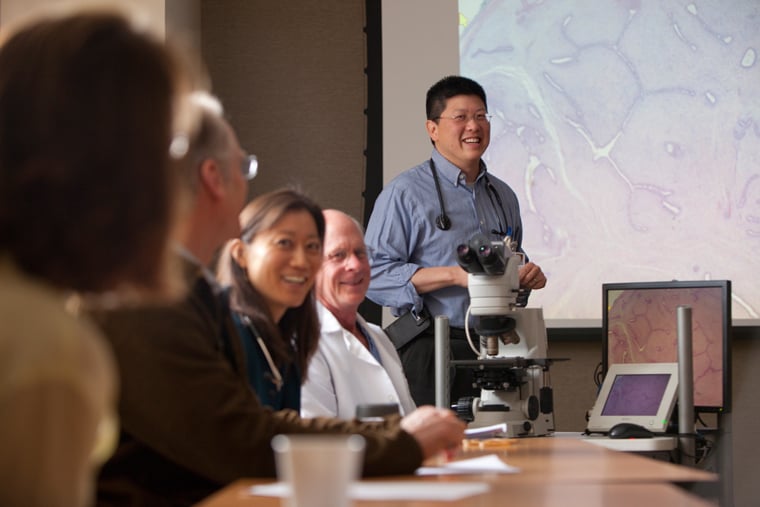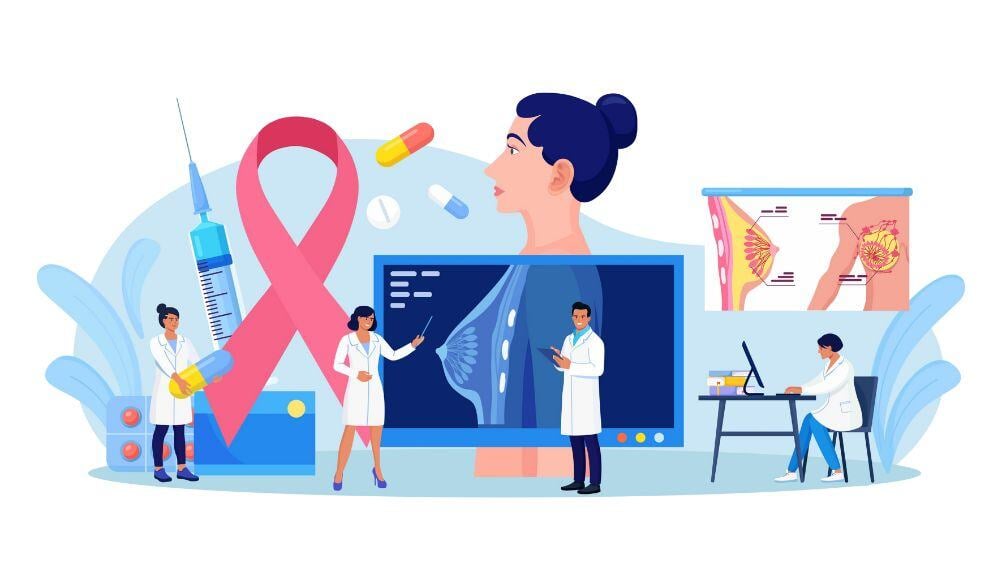By Emily Goodykoontz
The Register-Guard
Date: Oct. 8, 2018
Major advances in diagnostics, surgeries and medical treatments made in breast cancer care are reshaping how doctors and patients approach the myriad challenges.
“We have more tools in our toolbox to treat cancer patients, and even when cancer has spread, now we have more treatments to help patients live longer,” said Dr. Benjamin Cho, an oncologist at Willamette Valley Cancer Institute and Research Center (WVCI) in Eugene.
Cho, who is part of U.S. Oncology Network, has been able to bring national clinical trials to the Eugene-Springfield area. Trials are often the key to cancer treatment breakthroughs and FDA approval. Clinical trial researchers are looking for new therapies and ways to combine therapies for the best treatment outcomes.
Here are some of the advances being used locally that are transforming the breast cancer treatment process, giving doctors and patients more options and newfound hope.
Advancement 1: Combination Immunotherapy Treatments
Immunotherapy has been in the headlines lately. Dr. James P. Allison and Dr. Tasuku Honjo were awarded the Nobel Prize in Medicine last week for breakthrough work that’s given rise to new drugs called checkpoint inhibitors, bringing lasting remission to many cancer patients.
Immunotherapy activates the body’s immune system to fight cancer, and researchers have had huge success stopping destructive cancers such as leukemia, lymphoma and even melanoma. It’s something Cho and others at WVCI have brought to the Eugene center in clinical trials.
“We really saw a big spike in the number of patients about four years ago when we started having a new type of treatment called immunotherapy — using your own body to fight cancer,” Cho said.
Until recently, immunotherapy showed little promise for breast cancer patients, Cho said.
Researchers at the National Cancer Institute published a study in 2018 with surprising results. Led by Dr. Steven A. Rosenberg, they tried a combination of two immunotherapies that led to the complete remission of breast cancer in a patient with no other treatment options left. Two years later she is still cancer free, Cho said.
“It does show people like me, who do breast cancer research, promise that maybe one day we could cure breast cancer that has spread,” Cho said.
He hopes to become involved in a similar trial at WVCI in the next two years and is working toward it, but he said there’s no guarantee. The institute is currently running a clinical trial on another immunotherapy in combination with a hormone therapy for a specific type of breast cancer.
Advancement 2: Targeted Treatments, Antibodies and Smart Bombs
Cho calls standard chemotherapy the “atomic bomb treatment.” It’s injected into a breast cancer patient’s body through a surgically inserted port in her chest, and it affects all the cells in the body, causing collateral damage to healthy tissue and organs. Combinations of drugs, radiation and chemotherapy often work best, and doctors still are doing clinical trials to find out which combinations have the best success rates, depending on the type and stage of cancer. They’ve made life-prolonging breakthroughs with some of the most aggressive types of cancer.
“We’ve developed antibodies to certain cancers like (the antibody) Herceptin for breast cancer,” Cho said.
An antibody is an immune system protein that removes threats such as bacteria, viruses and cancer cells. Taking Herceptin, the brand name for trastuzumab, is kind of like getting a flu shot, Cho said — albeit with a few more side effects.
“When you get a flu shot you get flu proteins and your immune system recognizes it as foreign and develops designer immune antibodies for them,” Cho said.
The drug is effective in women with an aggressive cancer containing high levels of the protein HER2/neu, decreasing risk of cancer returning by 50 percent, Cho said.
“Before we had Herceptin, these types of cancers would come back in the brain, liver and lungs,” he said. “It made a very aggressive cancer’s risk so much less, to the point that it’s similar to breast cancers without HER2.”
Doctors added another antibody, pertuzumab, to the mix and found the combination of chemotherapy and two antibodies keeps cancer at bay for years, Cho said.
In another development, a “smart bomb” delivers chemotherapy directly to cancer cells, linked to an antibody such as Herceptin that targets cancer.
“The chemo gets released within those cancer cells so healthy cells don’t get as much collateral damage,” Cho said.
Advancement 3: Breast Cancer Staging and Sentinel Lymph Node Biopsies
Lymph nodes are located throughout the body, linked by lymph vessels that carry lymph fluid. The fluid simultaneously nourishes cells and carries away waste, bacteria and viruses.
“When cancer moves to another part of the body from the breast, it has to go through the lymph nodes,” most commonly invading the liver, lungs, brain and bones, said surgeon Dr. Winnie Henderson, who treats breast cancer patients at Northwest Surgical Specialists in Springfield.
Each breast cancer is different, and to understand how far it has advanced — if it has spread — doctors must “stage” the cancer, testing lymph nodes for cancer cells at or near the primary tumor. These nodes are known as the “sentinel lymph nodes.”
Before 2010, surgeons would remove all the lymph nodes in a breast cancer patient’s axillary, or armpit area, to stage the cancer and prevent recurrence in the same area, Henderson said. This would often lead to a serious complication called lymphedema about 50 percent of the time, she said.
A 10-year study of more than 5,000 patients showed that removing lymph nodes in women whose cancer hadn’t spread didn’t actually improve survival or recurrence rates, she said.
Henderson now uses the new standard in staging breast cancer: a sentinel lymph node biopsy. She checks the areas nearest the tumor by injecting a blue dye into the breast, following the dye as it flows to the nodes.
“It allows us to find the lymph nodes that are specifically draining the breast,” she said. “The lymphedema risk is only 5 percent for sentinel lymph node biopsy.”
Advancement 4: Fewer Mastectomies, More Breast Conservation and Oncoplastic Surgery
A mastectomy is a surgical procedure that removes a woman’s entire breast. Depending on a patient’s treatment plan it can involve a drawn-out reconstruction process.
“If patients have cancer in multiple places, we recommend a mastectomy,” Henderson said.
But 75 percent of the time at Northwest Surgical Specialists, the surgeons perform breast conservation, or a partial mastectomy.
“Psychologically, that is incredibly important for patients. When they look in front of a mirror after treatment, they still have a breast,” she said.
Henderson is trained in oncoplastic breast surgery, a combination of oncology, or cancer treatment, and plastic surgery. It’s one of the newer techniques that removes diseased tissue while reshaping the breast to look as natural as possible.
“All it is is a combination of achieving oncological results in addition to rearranging the breast tissue so the patient’s breast look the same or very similar to when they started out,” she said.
Related reading: Should Surgery Be Done Before Other Breast Cancer Treatments?
After patients have breast conservation surgery, they usually need to have radiation to reduce their risk of local recurrence, Henderson said.
“The radiation oncologist and the surgeon — myself — control the local disease,” she said. “What Dr. Cho and his colleagues do manages the systemic disease that would potentially be in other parts of the body.”
Related reading: How is Radiation Therapy Used to Treat Breast Cancer?
The Latest Treatments for Breast Cancer Available at Willamette Valley Cancer Institute
If you have been newly diagnosed with breast cancer, the first step is to schedule a consultation with a breast cancer specialist. At WVCI, we offer personalized treatment plans, including the latest cancer treatments available, as well as second opinions.
Originally published May 2018. Updated February 2025.




